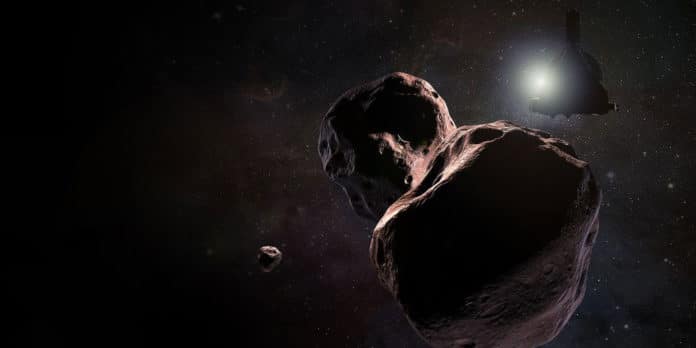Ultima Thule is located in the Kuiper Belt, beyond the orbit of Neptune. Located almost 6.5 billion kilometers from the Sun, The object is the most distant planetary flyby in history. In addition, the flyby of Ultima Thule was also the first investigation by any space mission of a well-preserved planetesimal, an ancient relic from the era of planet formation.
Recently, NASA’s New Horizons mission team just published results on the first Kuiper Belt flyby, and it explores the mysterious formation of Ultima Thule and details on its ancient past.
NASA discovered the evidence for a unique mixture of methanol, water ice, and organic molecules on the surface of Ultima Thule. Analyzing just the first sets of data gathered during the New Horizons spacecraft’s New Year’s 2019 flyby of MU69 (nicknamed Ultima Thule) the mission team quickly discovered an object far more complex than expected.
The initial data disclose much more about the object’s development, geology, and composition. Scientists are also investigating a range of surface features on Ultima Thule, such as bright spots and patches, hills and troughs, and craters and pits on Ultima Thule.
New Horizons Principal Investigator Alan Stern, of the Southwest Research Institute, Boulder, Colorado said, “We’re looking into the well-preserved remnants of the ancient past. There is no doubt that the discoveries made about Ultima Thule are going to advance theories of solar system formation.”
According to scientists, the largest depression is a 5-mile-wide (8-kilometer-wide) feature the team has nicknamed Maryland crater – which likely formed from an impact. Some smaller pits on the Kuiper Belt object, however, may have been created by material falling into underground spaces, or due to exotic ices going from a solid to a gas (called sublimation) and leaving pits in its place.
Some smaller pits on the Kuiper Belt object, however, may have been created by material falling into underground spaces, or due to exotic ices going from a solid to a gas and leaving pits in its place.
In color and composition, Ultima Thule resembles many other objects found in its area of the Kuiper Belt. Its reddish hue is believed to be caused by modification of the organic materials on its surface.
Ultima Thule measures approximately 30 kilometers (18 miles) in diameter and is irregularly shaped. At about 22 miles (36 kilometers) long, Ultima Thule consists of a large, strangely flat lobe (nicknamed “Ultima”) connected to a smaller, somewhat rounder lobe (nicknamed “Thule”), at a juncture nicknamed “the neck.”
However, scientists have not yet known about the unusual shapes of these lobes. As believed, the lobes likely once orbited each other until some process brought them together in what scientists have shown to be a “gentle” merger.
Scientists noted,”For that to happen, much of the binary’s orbital momentum must have dissipated for the objects to come together, but it is still unclear if that was due to aerodynamic forces from gas in the ancient solar nebula, or if Ultima and Thule ejected other lobes that formed with them to dissipate energy and shrink their orbit.”
“The alignment of the axes of Ultima and Thule indicates that before the merger the two lobes must have become tidally locked, meaning that the same sides always faced each other as they orbited around the same point. ”
Data transmission from the flyby continues and will go on until the late summer 2020. In the meantime, New Horizons continues to carry out new observations of additional Kuiper Belt objects it passes in the distance. These additional KBOs are too distant to reveal discoveries like those on MU69, but the team can measure aspects such as the object’s brightness. New Horizons also continues to map the charged-particle radiation and dust environment in the Kuiper Belt.
The team publishes the first peer-reviewed scientific results and interpretations – just four months after the flyby – in the May 17 issue of the journal Science.
